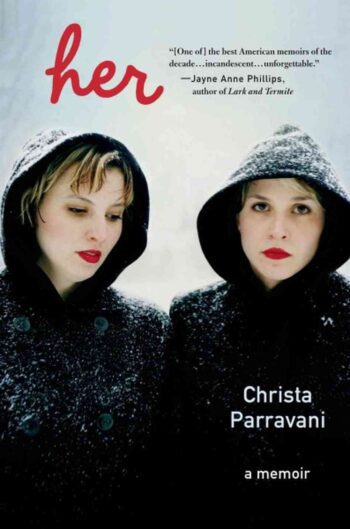
A few years after her identical twin sister Cara died, Christa Parravani read that when an identical twin dies, fifty percent of the time the surviving twin dies within two years. “Flip a coin,” Parravani writes, “those were my chances of survival.”
In her new memoir Her, Parravani tells the story of her sister, whose brutal rape led to a heroin addiction and her eventual death by overdose at the age of 28. Cara was studying fiction at UMass-Amherst’s MFA program. Christa was a successful photographer. They shared beauty and talent. They were intensely competitive. They were rivals, but also best friends. When Cara died Christa spiraled into depression and drug addiction. Used to mimicking her sister, she tried to emulate Cara’s self-destructiveness.
Her is a tale of survival, of a woman’s struggle to live as an individual after spending much of her life as one half of a whole. Parravani raises questions that affect all of us: How do we forgive ourselves for not being able to save the ones we love? How do we survive the loss of a family member? At the same time, it’s a tale of the complexity of the intertwined dynamics that are always at play in a twinship.
I’ve been waiting for a book like Her my entire life. As an identical twin, I was excited to find a memoir that sheds light on these particular challenges. In popular culture, the twin relationship is viewed as harmonious and ideal. Twins are seen as cute and sometimes mischievous, switching classrooms, confusing people, double trouble, happy in their sameness. Although many scholarly articles, parenting guides, psychology books, and fascinating separation narratives have been written on twins, few books explore growing up in a twinship from the inside. In reality, the process of separation and individuation among adult twins is often a fraught one.
What happens when a pair of twins, who from early childhood developed identities based on being seen as equal, as the same person, develop differences in aptitudes, personalities, and needs? What happens when one twin is perceived as healthier or more successful than the other? What happens when their experiences diverge? In Parravani’s case, what happens when trauma divides them?
Parravani writes of her sister’s rapist, “He’d un-samed us. When he defiled my Cara, he separated us.” After the rape, Parravani fantasizes that Cara’s rapist will find her too: “Attacked, I’d be the same as Cara again — we’d both be as dirty as she said she felt. It was the only way I’d be able to know what she meant when she told me we couldn’t be twins anymore. I was ‘still clean’.”
When Cara dies, Christa tries to become her sister. She takes Cara’s pills. She moves alone into a house filled with her sister’s furniture. She checks herself into mental hospitals, as Cara did. She nearly dies. She looks into the mirror and sees her sister staring back: “I saw my sister when I tried to see myself.”

Research shows that identical twins don’t develop a separate sense of themselves until they are four months old. Until then, twins sharing a crib may be unable to tell whose foot belongs to whom. As adults, twins often feel an intense need for closeness in order to recreate what they had with their brother or sister. They tend to be comfortable with intimacy. They are open to sharing thoughts and feelings.
“I wet my marital bed,” Parravani writes. “I mixed Cara’s ashes into eye shadow and dusted my lids. I dipped a wet finger down into a baggie of ash and tasted her bones.” It’s Parravani’s extraordinary emotional honesty as she shares such details, her willingness to lay her suffering bare and wear it like a badge, that makes her book so revealing.
In one of the most memorable scenes in her book, Parravani recounts a snowy afternoon spent with her sister two years after Cara’s rape and two years before Cara’s death. “If you die,” Cara tells Christa, “I’ll kill myself.” Christa counters, “If you die, I’ll survive you.”
I’ve had a similar conversation with my own sister. I imagine it is a conversation many twins can relate to. A few months ago my twin sister told me about an afternoon three years ago when she considered committing suicide by jumping off an overpass. How can I describe the perplexing and varied emotions I felt when she shared this with me? Horror, but dulled by the passage of time between the incident and its telling. Guilt that I was the healthier twin. Gratitude, certainly. A sense of arbitrariness — “Dad happened to call while I was considering it,” she explained. Was one phone call all that allowed me to continue having a sister today? “I doubt I would have gone through with it even without the phone call,” she said, seeing my face. But I have to wonder.
The worst part was that for days after this revelation I imagined my sister jumping off the bridge. In my imagination, I am left utterly alone. Strange as it seems, I feel free. Alternately, I imagined my sister not only jumping, but me following her into the rush of memory, where neither of us is happier or more successful or healthier than the other. We’re waving, our arms reaching, grasping at each other, letting go, falling, floating, equal.
I cannot fathom the grief of losing my twin sister, yet it is a fear I live with every day. It’s a fear that belongs to every one of us who’s learned to depend on someone to the point where we no longer know how to stand alone.
Her is one of the bravest books I’ve ever read. On every page we see Christa writing her way out of the deepest despair to emerge as her own person. The beauty of Her is that it’s both universal and distinct. This is Christa’s very particular ode to Cara. But it’s also about identity. To borrow from Hilton Als, who has written about twin loss: “It’s the story of any of us, trying to be alone together.”




